Thursday, September 12, 2013
GC9X #23 - Home Sweet Home!
For the month of September, GC9X has a spooktacular game for you in the form of Sweet Home! Released in 1989 by Capcom and based on a film of the same name, Sweet Home has the distinction of being one of the first ever survival horror games (alongside Project Firestart, released the same year). Sweet Home is all about managing your dwindling resources and making the best use of your characters' items, a mechanic that would be featured in Sweet Home's spiritual successor Resident Evil.
That's not all that's in store for you! The runners up of this month's GC9X vote, Chakan the Forever Man and Majyuuou, are this month's Game's Nite featured games. A livecast covering both games and similarly spooky titles will be shown this upcoming Sunday, September 15th, stream time to be announced.
Finally, later this month, xerxes will do live commentary of the Sweet Home movie, so be sure to stay tuned!
As always, you can follow GC9X on twitter for current and future updates.
(screenshot courtesy of MobyGames)
Wednesday, September 11, 2013
Update 9/12 (plus 9/2) - Cowboy Kid, Flashgal, Desert Breaker, Thor's Hammer Trilogy, Pyongyang Racer, Shadowrun, Rolling Thunder, Fatal Fury, Gotcha Force, Hourai Gakuen no Bouken!, Totally Rad, Altered Destiny, Radix
Cowboy Kid is one of those late-generation NES games that barely got any distribution, and as such, is a little pricey to get a hold of on the secondary market. Seriously, I never saw any reviews at the time, and even after years upon years of retro game prowling, never happened upon it once. Anyway, conspiracy theory time - I have no proof of this, but this game almost feels like Konami was trying to make an Americanized version of Ganbare Goemon 2, but was cancelled, and covertly shipped off to another publisher. It just rips it off so closely, and it's such an odd game to make a clone of.
For oddball Sega stuff for this update: In the comic book scene, there's continual growsing that all kinds of superheroes have gotten movies, yet Wonder Woman has been continually neglected. The same thing happened in the realm of video games...with the (kind of) exception of Flashgal. We say "kind of" because it's not an officially licensed Wonder Woman game, but the protagonist is so closely modeled after her that she may as well be. Additionally, a few months back we covered an arcade game called Bullet, a three player run-and-gun that was suspicious similar to Capcom's Mercs, despite predating it by some time. A few years later, they put out a game called Desert Breaker, which patterns itself after Mercs so closely it's almost uncomfortable. Still, if you're going to steal, might as well steal from the best, and it's actually a fairly decent game.
For everyone's that missed the Weekly Kusoge column, we bring you a thrashing of Pyongyang Racer, the browser-based racing "game" that's meant to, somehow, promote tourism to the North Korean capital. And we reach deep back into the realm of the mid-90s shareware scene to dig out Thor's Hammer Trilogy, a very early first person shooter with a fantasy theme. It's...well, it's not Hexen, which is putting it lightly. And the iOS shooter column now covers arena based shooters, including MiniSquadron, Space Miner Blast, Space Junk and XPilot.
As sort of a follow-up to the Leisure Suit Larry update from last week, we've revamped the Shadowrun article to include a new review of the Kickstartered sequel, Shadowrun Returns, which draws heavily from the SNES cult classic rendition of role playing game. It also includes a review of the 2007 first person shooter, which was a fairly decent game, just one that no one in particular wanted.
Gotcha Force is one of the handful of Gamecube exclusive titles by Capcom. It's essentially a kiddie version of Virtual On, a 3D one-on-one robot fighting game, and one that's a lot of fun, in spite of its seemingly juvenile demeanor. Altered Destiny is another Accolade adventure game, essentially the more serious companion game to the Les Manley series posted in last update. It's a huge ripoff of Sierra games, and it's incredibly frustrating in parts, but I've a certain weakness for the sort of low-color, low-resolution artwork that late 80s/early 90s computer games used.
Hourai Gakuen no Bouken! (Adventures of Hourai High School) is a Super Famicom RPG that was fan-translated awhile back. Though an average game in its own right, with glitchy gameplay and a near total lack of balance, it has an incredibly goofy sense of humor that makes it worth checking out. Radix: Beyond the Void hails from the era of Doom clones, though in this first person shooter, you take control of a jet fighter rather than a human. It seems to be mistaken for Descent, but it's a much faster paced, more action-y take on the formula. Totally Rad is a 8-bit NES platformer which capitalized on early 90s jargon, and still manages to be a decent Mega Man-type game.
The latest 500 Word Indies covers Droidscape: Basilica, an innovative iOS action-puzzle game where you trace routes through mazes and control a stop motion animated bipedal robot through a series of traps. Game Club 199X Episode 21 discusses Master of Orion, Microprose's PC outer space strategy sim. And the Best of PC Engine / Mega CD Music column features Annet Futatabi, The Terminator, and Ai Choaniki.
Monday, September 9, 2013
Bringing back the ad in adventure (1): Das Erbe
I still haven't quite mustered the strength to continue my series on ancient RPGs from Japan, so here's something completely different, something that's closer to home for me.
For my country having been the number one consumer of point-and-click adventure games practically since the genre existed, I've always wondered why there were hardly any adventure games made in Germany during the '90s, as the industry only really seemed to pick up on developing them long after the stream of new titles from the US had dried up. I understand there had been a healthy text adventure scene in the C64-days, and a handful of first person adventures, but the only traditional LucasArts/Sierra style games I knew of were Chewy: Esc from F5 and Imperium Romanum (the latter seems to have never been released in English, as far as I know).
But it turns out I was wrong all the time. In actuality, there's a ton of German-developed point-and-click adventures from that era, and I even had played a lot of them back in the day, but I just blanked them out off my radar, because mentioning them almost seems like a dirty word: They're advertisement games! Commisioned by private companies or public institutions, they solely exist to sell goods or ideas. Almost all of them are quite short, but a few are actually not all that bad. So I wanted to take a closer look at some of them.
Das Erbe - Amiga, IBM PC (1991)
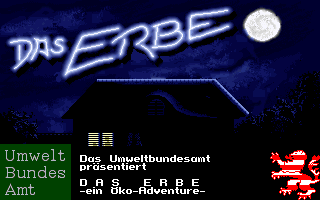
Das Erbe ("The Heritage") was actually the first point & click adventure game I ever played, on a friend's Amiga (all the screenshots here are from the IBM PC version, which has slightly retouched graphics). Commissioned by the German Federal Environmental Agency, it's all about preserving the earth's atmosphere. You play as some dude how inherited a house and three million Deutsche Mark from his late uncle, under the condition that he'd renovate the house without damaging the environment.
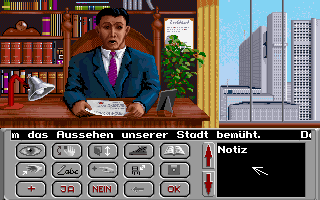
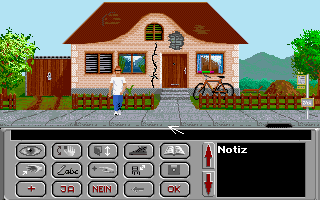
The commands are obviously inspired by the early LucasArts adventures, although the game already uses icons instead of plain text buttons. It's still more inconvenient, though, as hotspot names only appear after clicking on them. The commands are look at, use, open/close, go (has to be selected each time before going somewhere), read (very important and distinguished from look at), take (something out of), write (completely useless cause you only have to write something once, and then it can be done by using the pen with the paper), buy, sit down (useless), and save.
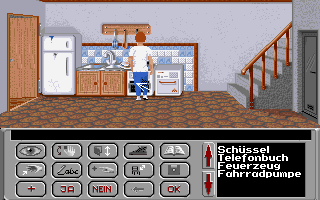
The plus sign in the bottom row actually has to be used to combine items with one another. The syntax is USE [first item] + [second item]. At certain points in the game you will be asked questions that can be answered with Yes or No, which also have two extra buttons, the arrow pointing left is there to delete a command. For example, if you press the "write" button but there's nothing to write on, you cannot go on until you press that arrow. "OK" is used to confirm combining items in the inventory.
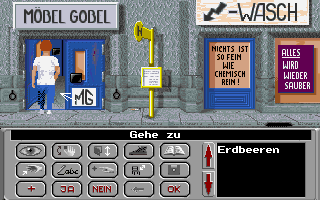
The main task only consists of two major parts. The first one involves getting replacements for all the broken furniture. So you take the bus into the city (apparently you traveled there without a penny in your pocket, so find some money first), and go into the furniture store. It has two models of each type of furniture. The descriptions are always painfully obvious as to which one is better for the environment. If you buy the wrong one, you see an animation of the earth dying, get some error points and have to try again.
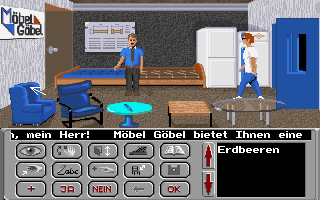
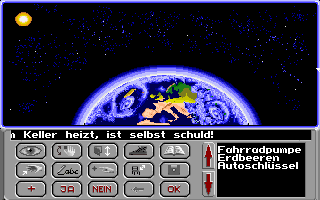
You also need a fire extinguisher from the general store. If you try to "USE" the cashier, she says "Maybe later, boy."
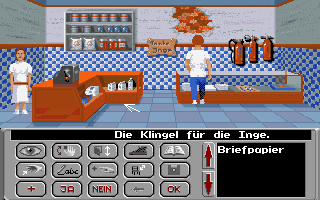
Then comes the actual work on the house, which of course you don't do yourself. You just have to find a phone book in a drawer, then call all the different workers to get the house painted, isolated, the boiler replaced, the broken furniture removed, and the water tap repaired. All the calls just boil down to someone asking you "DO YOU WANT TO DESTROY THE PLANET OR NOT?"
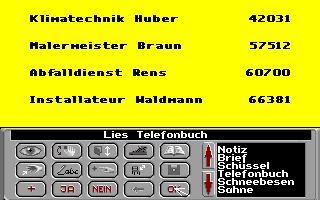
If all this is done, you can write a letter to the Environmental Agency (the paper has to be bought, the stamp can be found under the bell in the general store). But in order to do that, you first have to get your bike in working order by finding the key to its lock and an air pump for the tire. Next to the post box are two fast food restaurants, which are useless, but the international chain is also bad for the environment, so stay out of it.
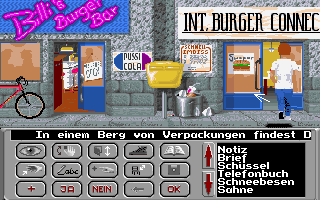
Sending the letter makes a friendly man arrive in front of the fixed house and hand you the environmental ceertificate. You get 3 million, the end.
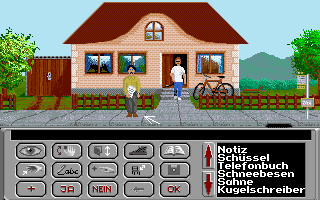
But wait! There is actually a side quest that's much more interesting than the main task: In the living room you can find a picture of a girl, on the back it has her phone number and introduces her as your uncles stepdaughter LOLITA, so the guy immediately decides he has to date her (creepy, yes). Up in the sleeping room/home office in the attic is the phone. When calling her, she says she wants to meet you and she wants you to prepare her strawberries with cream.
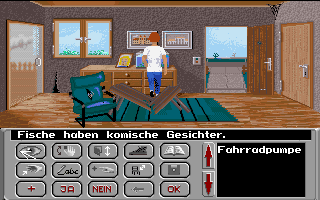
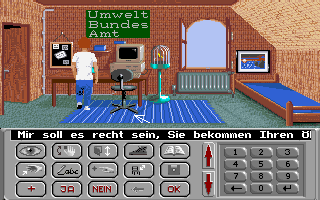
Strawberries you can find in the garden, cream has to be bought in the general store. You cannot buy the canned cream because of the gas, but fortunately there's an eggbeater and a bowl available in the kitchen. Then you have to use the computer upstairs (after connecting the keyboard, puzzle yeah), order flowers and buy your train ticket online(!) to her home. (Oddly, if you succeed in meeting her, you see the two of you sitting arm in arm in YOUR garden.)
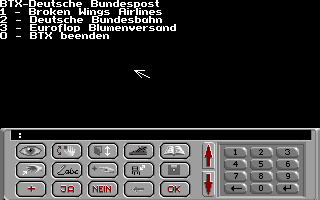
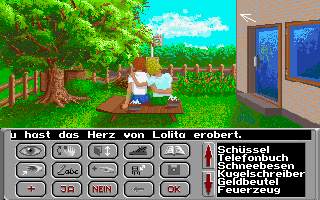
Das Erbe has a number of amusing WTF-grade death scenes:
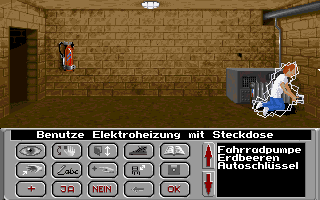
There's an electric heater in the cellar, which you can plug in. To teach you ho wrong it is to heat a cellar, the game kills you with an electric discharge.
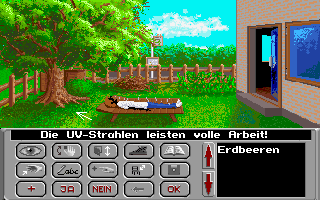
If you lie on the lounger in the garden, the sun roasts and kills you. Ouch!
Also in the garden, you can try to burn a pile of leaves with a lighter, with cruel results:
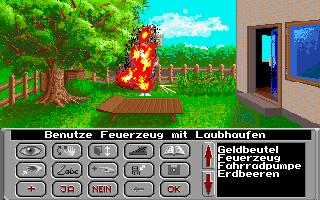
The safe way to get rid of it is a hardly visible box for compost behind the tree. I don't actually know if you have to remove it (might be necessary for the romance side quest), but if you do your clothes get dirty and you have to go a laundry room in town. The guy then just takes off his clothes at the location to wash them.
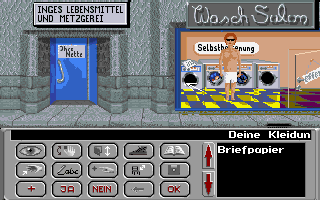
Overall, Das Erbe is a neat little adventure, although its message can be a bit too blunt and the solutions all too obvious. The only real obstacles in the main quest is finding the stamp. There's also a sequel called Das Schmutzige Erbe ("The Dirty Heritage"), but apparently it wasn't very good, and by the time it came out overshadowed by better advertisement adventures.
Thanks go to the German blog Werbespiel-Archiv, for preserving and cataloging these adgames. It also has the German DOS version for download. And you can take a look at the sequel there.

